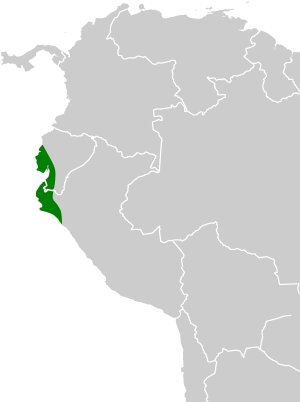White-edged oriole facts for kids
Quick facts for kids White-edged oriole |
|
|---|---|
 |
|
| Conservation status | |
| Scientific classification | |
 |
The white-edged oriole (scientific name: Icterus graceannae) is a type of bird that belongs to the Icteridae family. You can find this bird living in the countries of Ecuador and Peru. It mostly lives in warm, wet or dry forests, often staying high up in the trees.
About the White-edged Oriole
The white-edged oriole was first described in 1867 by a naturalist named John Cassin. He named this bird to honor Graceanna Lewis, who was a very important early American female scientist who studied birds. Cassin's description of the bird was first published in a science paper called Proceedings of the Academy of Natural Sciences in Philadelphia, also in 1867.
Where It Lives
This bird's natural habitats are usually warm, dry forests or moist lowland forests in tropical areas. It prefers to live high up in the trees, in the part of the forest called the canopy.
How We Protect It
Experts believe that the white-edged oriole is not in danger of disappearing. This is because it lives in many different places and can adapt to various types of forests. Scientists have not yet measured exactly how many of these birds there are or if their numbers are changing. However, Birdlife International lists the white-edged oriole as a species of Least Concern. This means it is not currently considered threatened.
See also
 In Spanish: Turpial aliblanco para niños
In Spanish: Turpial aliblanco para niños
Images for kids




